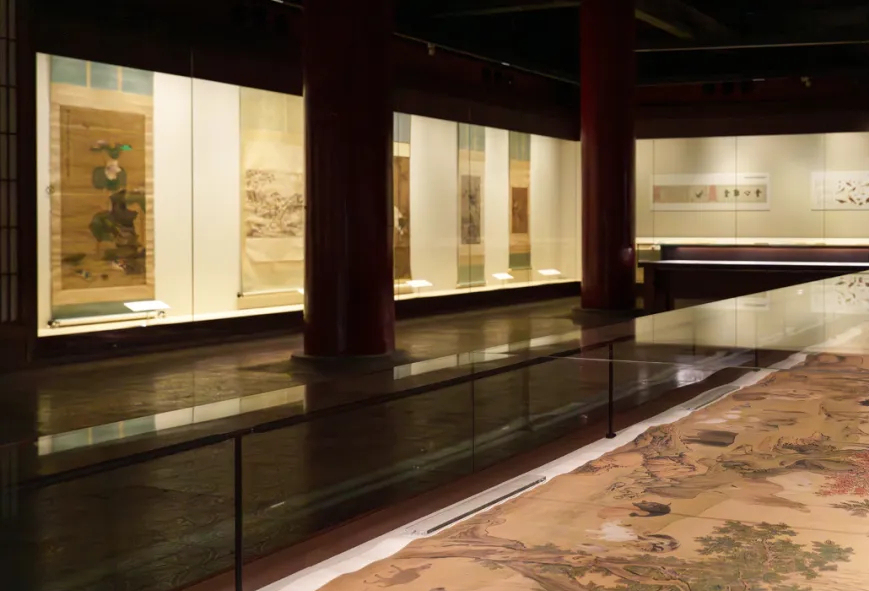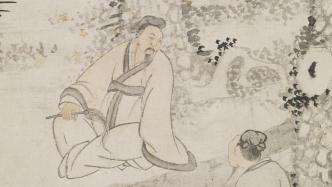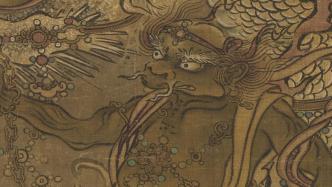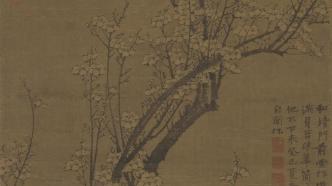
On the fourteenth day of the twelfth lunar month, Xiao Han.
Zhu Shuzhen, a female poet in the Song Dynasty, said, "The sunflower shadow will move to the sun, and the plum blossom will bloom first in the cold." In the severe cold, the letter of flowers arrives as promised. The plum blossoms have just bloomed since the cold weather, and the dark fragrance and sparse shadows add a bit of color to the sparse and cold world.
Among the calligraphy and paintings of the past dynasties, Song Huizong's "Winter Plum and Mountain Birds" is both poetic and picturesque. In addition to sketching, it also has a sense of modeling beauty and a cool winter atmosphere; Beautiful as silk; Song Yangwujiu's "Four Plum Blossoms" volume depicts plum blossoms with light color, sparse fragrance, and refreshing air; Yuan Wangmian's "Painting Southern Branches in Spring Morning" is vigorous and straight, full of flowers.
In this cold winter season, "The Paper·Ancient Art" sorts out the famous plum blossoms in the paintings of the Palace Museum and the Taipei Palace Museum for readers.
Song Huizong Wintersweet Mountain Poultry Axis

Song Huizong Wintersweet Mountain Poultry Axis Collection of the National Palace Museum, Taipei
Zhao Ji (1082-1135), Emperor Huizong of Song Dynasty, was an artist emperor who excelled in poetry, calligraphy and painting. The concept of painting has a profound influence on the development of Chinese painting.
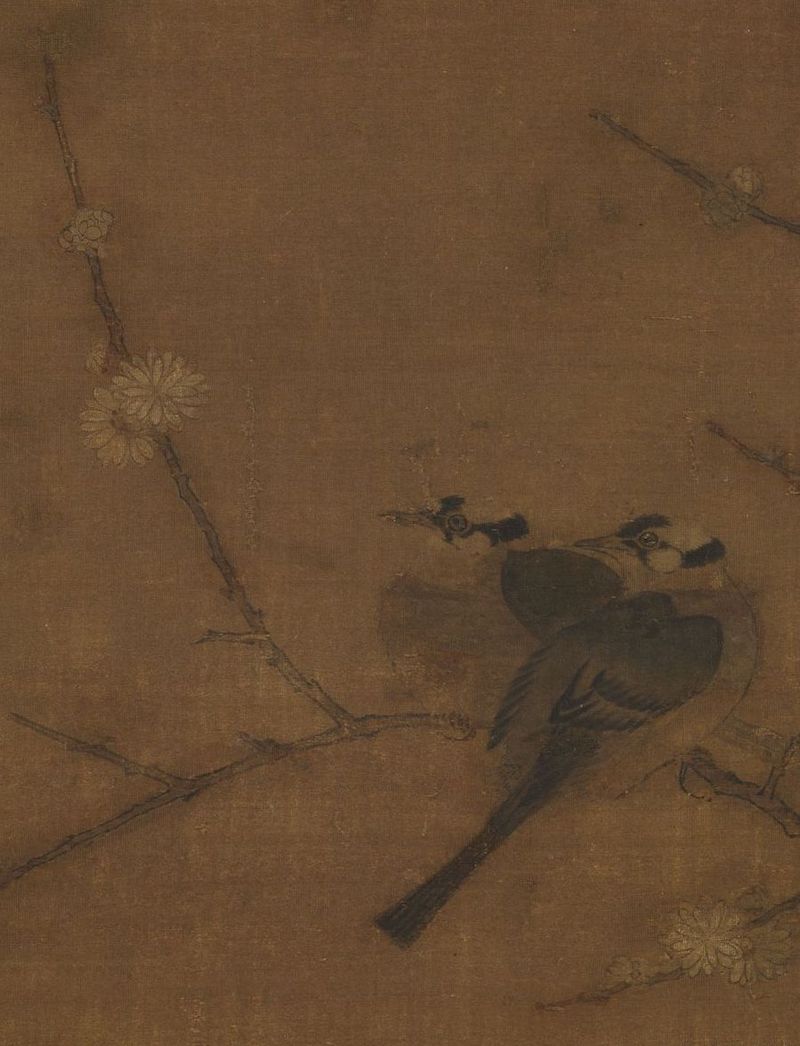
Wintersweet Mountain Poultry Axis of Emperor Huizong of Song Dynasty (partial) Collection of National Palace Museum, Taipei
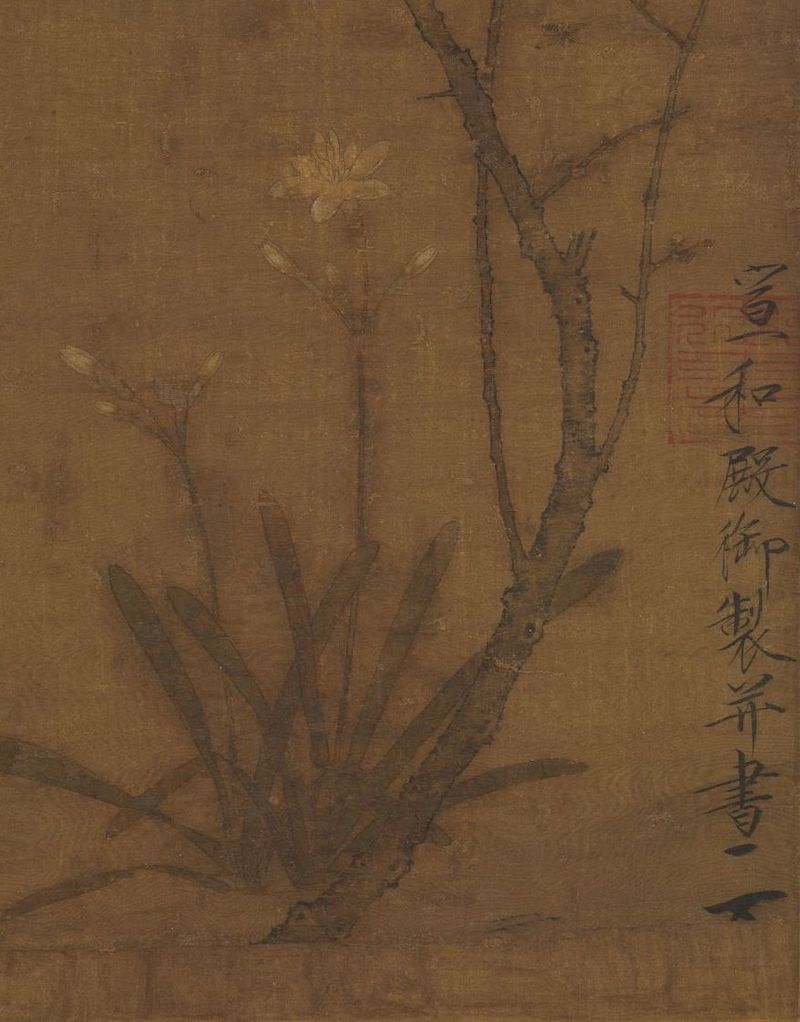
Wintersweet Mountain Poultry Axis of Emperor Huizong of Song Dynasty (partial) Collection of National Palace Museum, Taipei
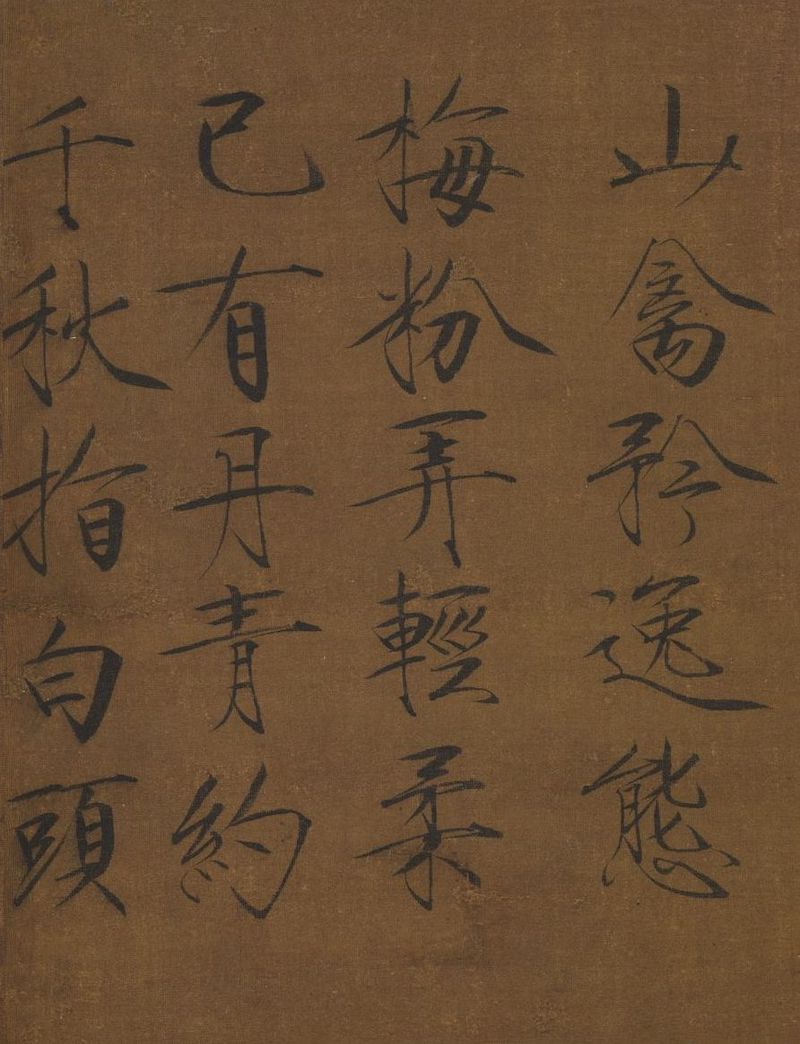
Wintersweet Mountain Poultry Axis of Emperor Huizong of Song Dynasty (partial) Collection of National Palace Museum, Taipei
This painting may be "The White Head of Xiangmei Mountain", one of Huizong's eight screens in "Song Zhongxing Guange Storage Picture Notes". , and intentionally create an ideal realm with a sense of modeling beauty and a refreshing atmosphere in winter.
Song Huizong Plum Blossom Embroidered Eye Page
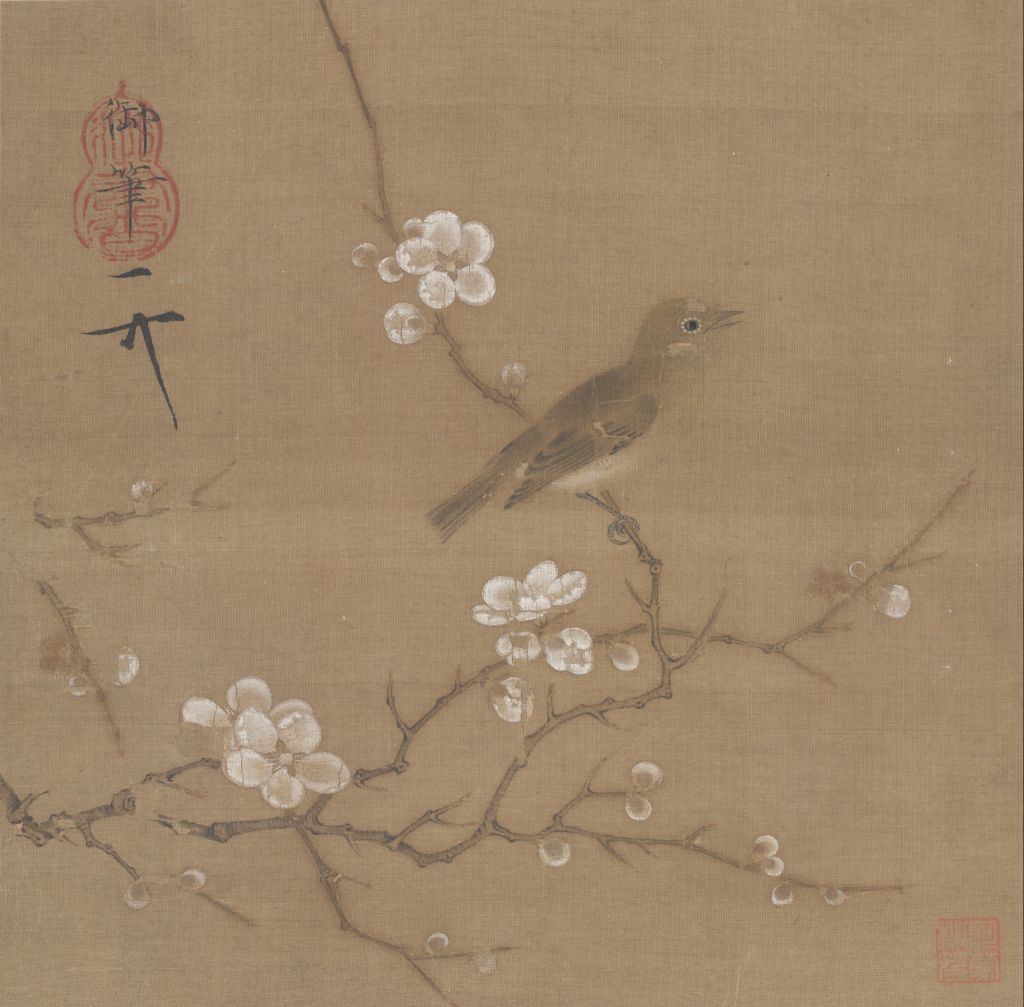
Song Huizong Plum Blossom Embroidered Eye Map Page Collection of the Palace Museum
In the picture, the plum branches are thin and strong, with sparse flowers and pistils on the branches, and a beautiful embroidered eye stands on the branch, singing Gu Pan, which contrasts with the beautiful plum blossoms. Although there are not many scenes in this picture, it is quite beautiful and moving. The plum blossoms painted are palace plums, which have been pruned continuously, and the traces of artificial modification are heavy. The painting method of this kind of plum is fine and delicate, the color is heavy, and it has a kind of rich and noble atmosphere. This style is favored by the court, and it obviously represents the aesthetic meaning of the royal family.
Southern Song Dynasty Ma Lin Layered Ice Texture Axis

Layered Ice Cream Axis of Ma Lin in the Southern Song Dynasty Collection of the Palace Museum
This painting is signed by "Chen Ma Lin". In addition, Empress Yang of the Song Dynasty titled the picture "Layered Ice Cream" and wrote a poem: "It's like a cold butterfly sleeping in a flower house, embracing the heart of sandalwood and recalling the old fragrance. It is especially lovely when it blooms in the cold shoots. This must be the makeup of the Han Palace. Give it to the king. "Qian: "Bingzikun Ningbao", "Zhang of Yang Surname".
The two plum blossoms painted in the picture are said to be green calyx plums, which are rare varieties of plum blossoms. The branches are slender and strong, and the flowers are dense and charming, all of which are painted with the double-hook coloring method. The painting method is fine, the layers are distinct, the turning of the branches and the back of the flowers are handled with care. White powder is applied thickly on the outer edge and back of the petals to emphasize, perfectly expressing the beautiful image of plum blossoms that are icy and clean, like yarn and silk. The description of Empress Yang's "layered ice cream" is appropriate and very poetic, which also adds a lot to this picture.
Song Yang Wugui Four Plum Blossoms Scroll
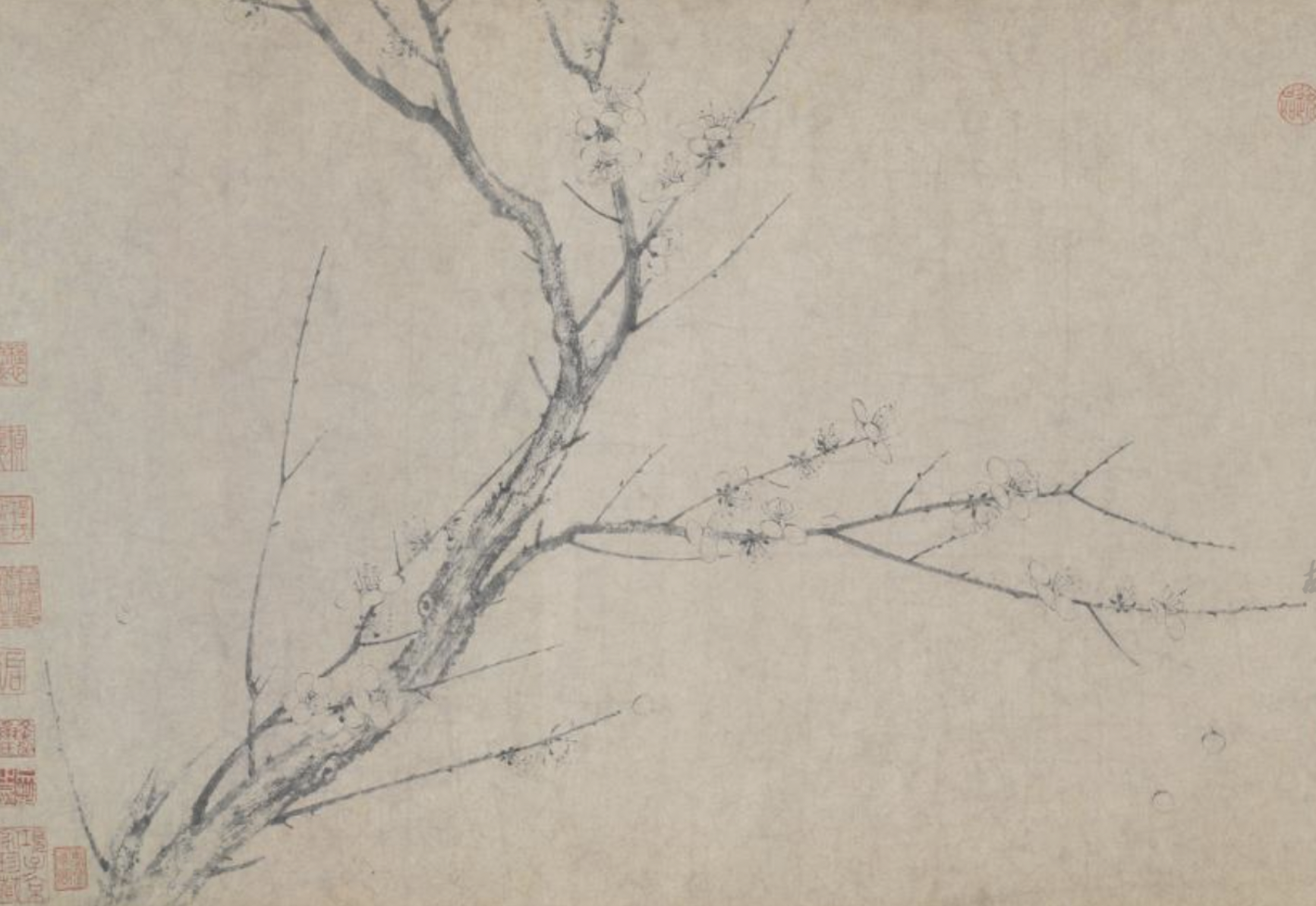
Song Yangwujiu's "Four Plum Blossoms" volume (partial) Collection of the Palace Museum
Yang Wujiu's Mo Mei, the ancestor of the Northern Song Dynasty Huaguang monk (Shi Zhongren). According to Wu Yuanyuan's "Songzhai Plum Book": "Momei began in Huaguang. " I can't understand what it means. On a moonlit night, I saw the sparse shadows on the horizontal window, which was sparse and lovely, so I used a brush to describe its shape, and saw it as a moonlit night, so I got its samadhi, and the name spread to the world." Yang Wuguide Huaguang's painting method has its own reform and development, changing the ink halo petals into ink pen circle lines, "turning black into white", which can better express the characteristics of plum blossoms with light color, sparse fragrance, and fresh air.

Song Yangwujiu's "Four Plum Blossoms" volume (partial) Collection of the Palace Museum
This scroll was written at the age of 69 by the artist at the request of his friend Fan Duanbo. It has four sections in total: unopened, about to open, in full bloom, and about to fade, depicting the whole process of plum blossoms from budding to early blooming, full bloom, and finally withering. . The branches are rubbed with Feibai method, the flowers are combined with double hooks and no bones, and the brush is round. The whole volume is purely in ink, without any color, but attention is paid to the changes of thick, light, dry, wet, and burnt, and the picture gives people a colorful feeling. It is said that the place where Wu Jiu lived when he was young "had a plum tree as big as several houses, with pale moss, and clusters of flowers." He often copied and copied paintings. Therefore, his paintings are both exquisite and lifelike, and full of bold and unconstrained freehand brushwork. At the back of the volume, there are four poems chanting plum blossoms in the self-book "Liu Shaoqing". The calligraphy is vigorous and powerful, which captures the essence of Ouyang Xun. It implies a kind of hidden emotion, which arouses the viewer's infinite emotions and feelings.
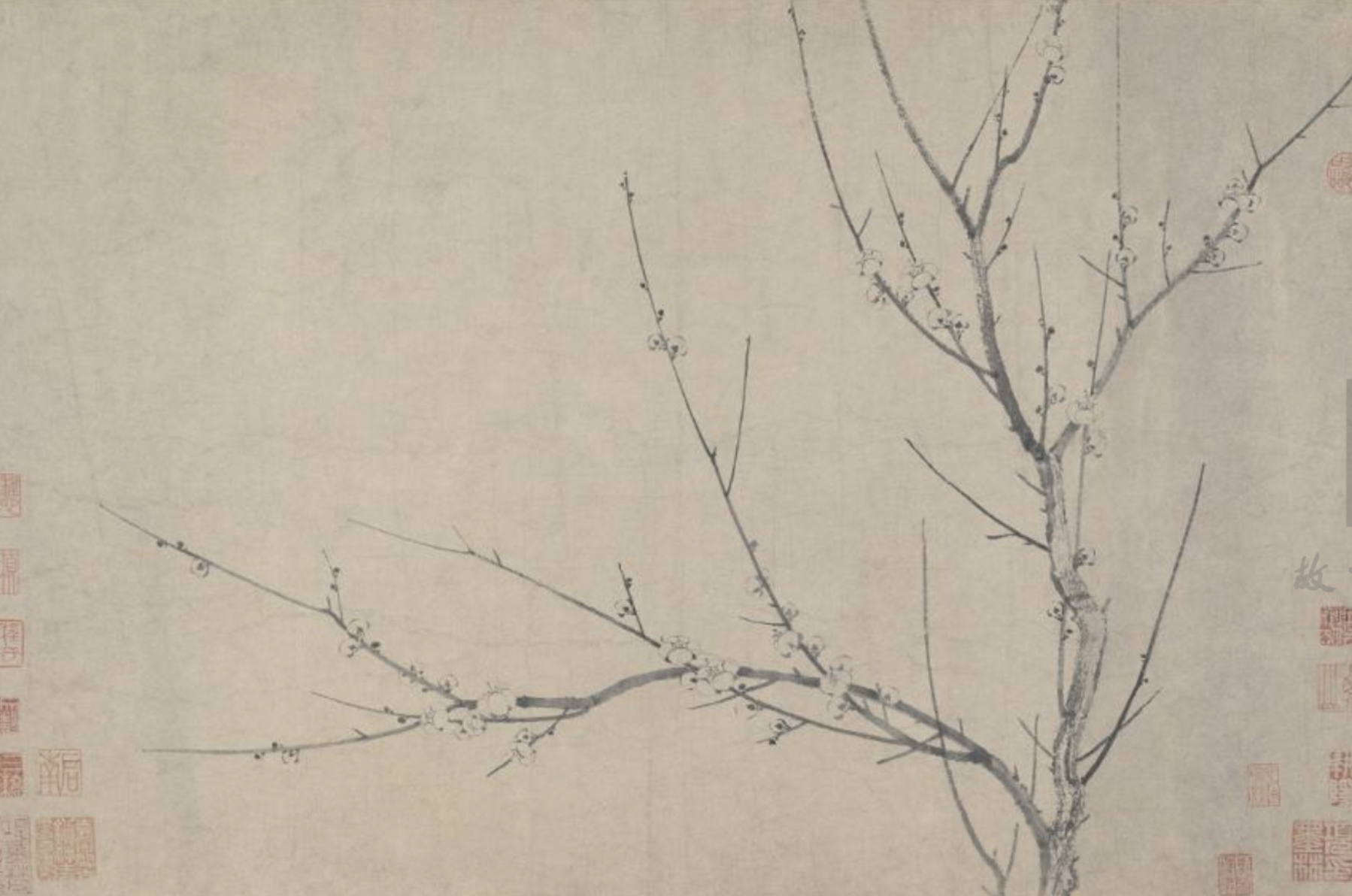
Song Yangwujiu's "Four Plum Blossoms" volume (partial) Collection of the Palace Museum
This volume has been described in "Iron Net Coral", "Qinghe Calligraphy and Painting Boat", "Coral Net Calligraphy and Painting Postscript", "Guoyunlou Calligraphy and Painting Notes", "Shigutang Calligraphy and Painting Collection", "Daguanlu" and so on. In the early years of Jiaqing, it was acquired by Lu Jinting, who specially built the "Four Plum Blossom Pavilion" to store it. Later, he was exiled in a foreign country, and was bought back by Cheng Zhenyi with "three hundred pieces of fan money", which was said to be a grand event in the art forest at that time. There are also Yuanwu Town, Ming Shenzhou, Wen Zhengming, Xiang Yuanbian and other people's collection imprints, which amount to more than 300 square meters, which is a well-known trace of Yang Wujiu.
Yuan Wangmian Painting Nanzhi Chunzao Axis
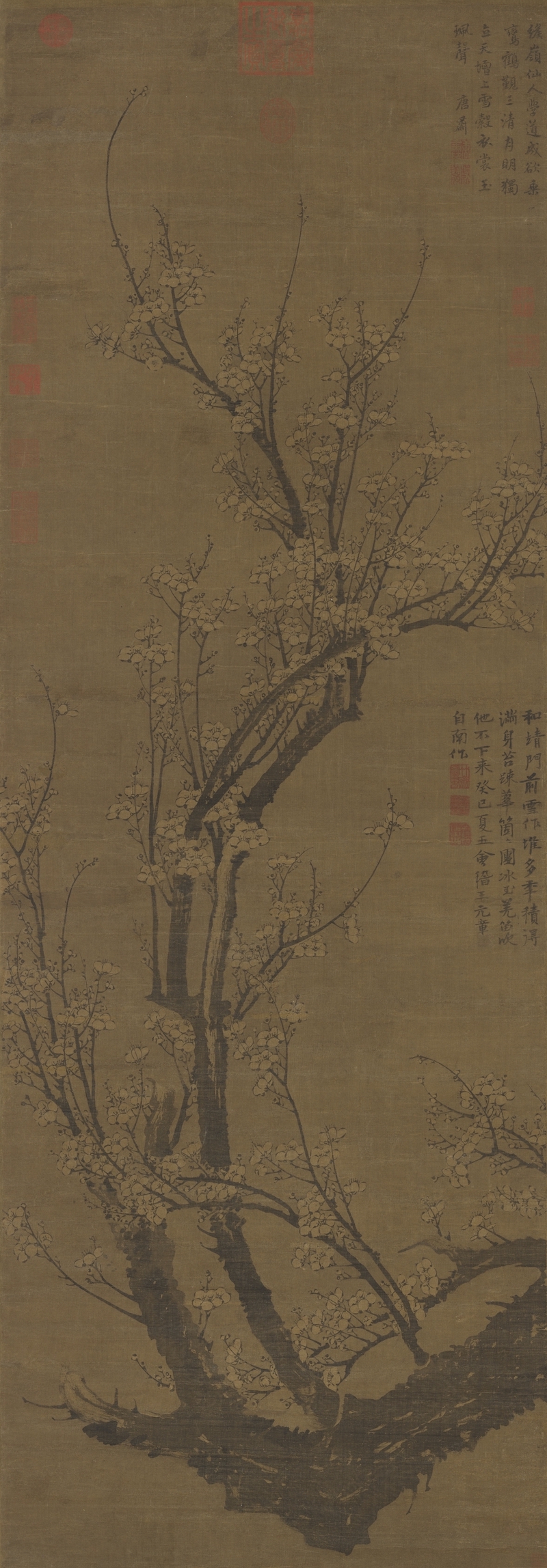
Yuan Wangmian Painting Nanzhi Chunzao Axis Collection of the National Palace Museum, Taipei
Wang Mian, character Yuanzhang, nicknamed Kuaiji Waishi, was originally from Zhuji, Zhejiang Province, and lived in Kuaiji. When he was young, his family was poor and he was a shepherd, but he loved reading very much. Later, he studied with Han Xing and eventually became a master of Confucianism. He was able to compose poetry and prose, and was also good at calligraphy and painting, especially good at painting ink plums. Plum blossom is one of the three friends of pine, bamboo and plum in Suihan. It blooms alone in the cold winter and has always been regarded as a symbol of a lonely gentleman. In the Southern Song Dynasty, Lin Hejing loved Mei, and he claimed to have Mei as his wife and Crane as his son. It is even more famous, and it is also the origin of the first line of the poem titled on this painting. Ever since Shi Zhongren in the Song Dynasty pioneered the painting of plums in ink and wash, this style of painting, which emphasizes brushstrokes and does not seek similarity in appearance, has been especially loved by literati. Wang Mian's ink plums can be said to be representative of this.

Yuan Wangmian Painting Nanzhi Chunzao Axis (Partial) Collection of National Palace Museum, Taipei

Yuan Wangmian Painting Nanzhi Chunzao Axis (Partial) Collection of National Palace Museum, Taipei
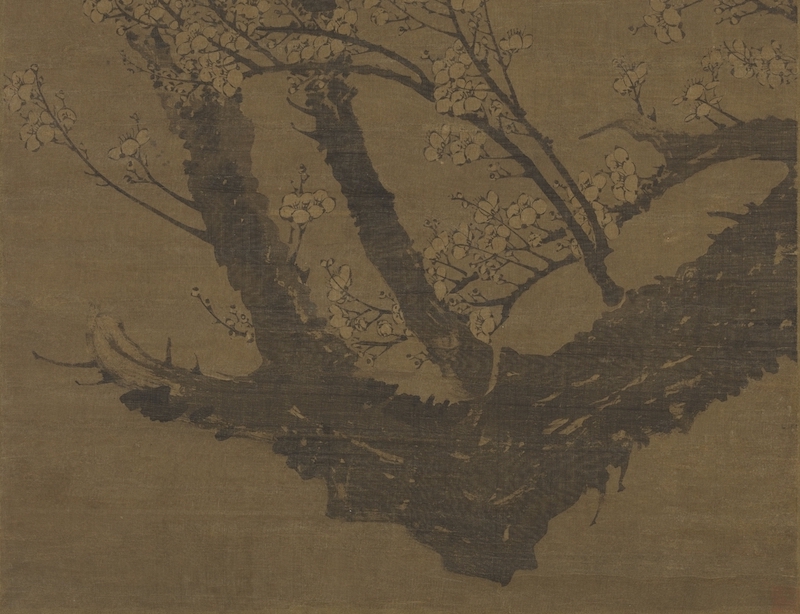
Yuan Wangmian Painting Nanzhi Chunzao Axis (Partial) Collection of National Palace Museum, Taipei
In this painting, a vigorous and upright dried plum is drawn from the lower right and upwards, with thin and tough branches all over the place, with numerous flowers and stamens, which are full of life and almost fill the picture. The petals are made up of dots made of ink circles. Under the whole frame dyed with light ink, the tiny white flowers look like snow-covered branches, making them appear noble and elegant. In Wang Mian's poem, he compared plum blossoms to jade, which symbolizes the gentleness and morality of a gentleman. This is also a common metaphor in Wang Mian's ink plum paintings. The last two lines of the inscription are lines often inscribed by Wang Mian, which may be interpreted by later generations as having the meaning of resisting foreigners, but the original "Luomeihua" in the ancient flute music may only express the connection in music, not necessarily Political connotation, otherwise Wang Mian would not have often written it like this.
Yuan Wangmian Painting Nanzhi Chunzao Axis

Yuan Wangmian Painting Nanzhi Chunzao Axis Collection of the National Palace Museum, Taipei

Yuan Wangmian Painting Nanzhi Chunzao Axis (Partial) Collection of National Palace Museum, Taipei
This painting has Wang Mian's own inscription in running script: "The beautiful flowers shine on the water, and I don't know when the spring will return." Nenhan Qingxiao Gushan Road, remember to search for a sentence. Ding Bingji's Dongshan Nong Wang Yuanzhang was written by Master Yunfeng.
Yuan Chen Lishan Ink Plum Axis

Yuan Chen Lishan Ink Plum Axis Collection of the National Palace Museum, Taipei
Chen Lishan, whose date of birth and death is unknown, was born in Huangyan (now Kuaiji, Zhejiang). From Emperor Shun of the Yuan Dynasty to the first year of Zhengyuan (1341), Guan Qingyuan Road Zhaomo. Gong Momei, whose work was circulated in the 25th year of Zhizheng (1365) at the latest. In this painting, there is a single black plum with sparse shadows and horizontal slanting. The main stem emerges from the right side of the painting, and it is full of curves. Chen Lishan's paintings of ink plums are as famous as those of Wang Mian (1310-1359). However, comparing the two, Wang Mian's works are elegant and meticulous, while Chen Lishan's plums are made of thin branches and light pistils that are slightly out of shape, expressing the interest of freehand brushwork. This painting was painted in the Zhizheng Xinmao (1351) year.
Ming Chen Daofu Plum Blossom Narcissus Axis

Ming Dynasty Chen Daofu Plum Blossom Narcissus Picture Axis Collection of the Palace Museum
The self-title of this picture: "Who knows that it is wrapped in ice and snow, but there is musk orchid fragrance." There are two collections and seals of "Tao Zhai Secret Book" Zhu Wen, and "Soochow Literature Hengshan Family" Zhu Wenjian.
Chen Daofu's freehand brushwork of flowers and birds was developed from the painting methods of Yuan people. Although he came from Shen Zhou and Wen Zhengming, he was not limited by his masters, and his works were peaceful and tranquil. In this "Plum Blossom Narcissus Picture", the plum blossom occupies the main position of the picture, and the branches stretch around, echoing the narcissus. The picture shows the vigor and wantonness of the plum blossom branches through the brush strokes such as frustrating and flying white. The plum blossoms are splashed with dripping ink, vivid and lifelike. The daffodils in full bloom are outlined with simple strokes, elegant and refined, quiet and timeless.
The painter can skillfully use and change the strokes, the thickness of the lines, and the shade of the ink according to the different objects, showing a sense of rhythm. This painting uses free and easy brush, dripping ink, free and delicate, simple and elegant, vividly showing the vigor and refinement of plum blossoms and the elegance and delicacy of narcissus, reflecting the brushwork of literati at that time in ink and wash freehand brushwork ink fun.
Ming Chen Xianzhang painted plum blossom scroll
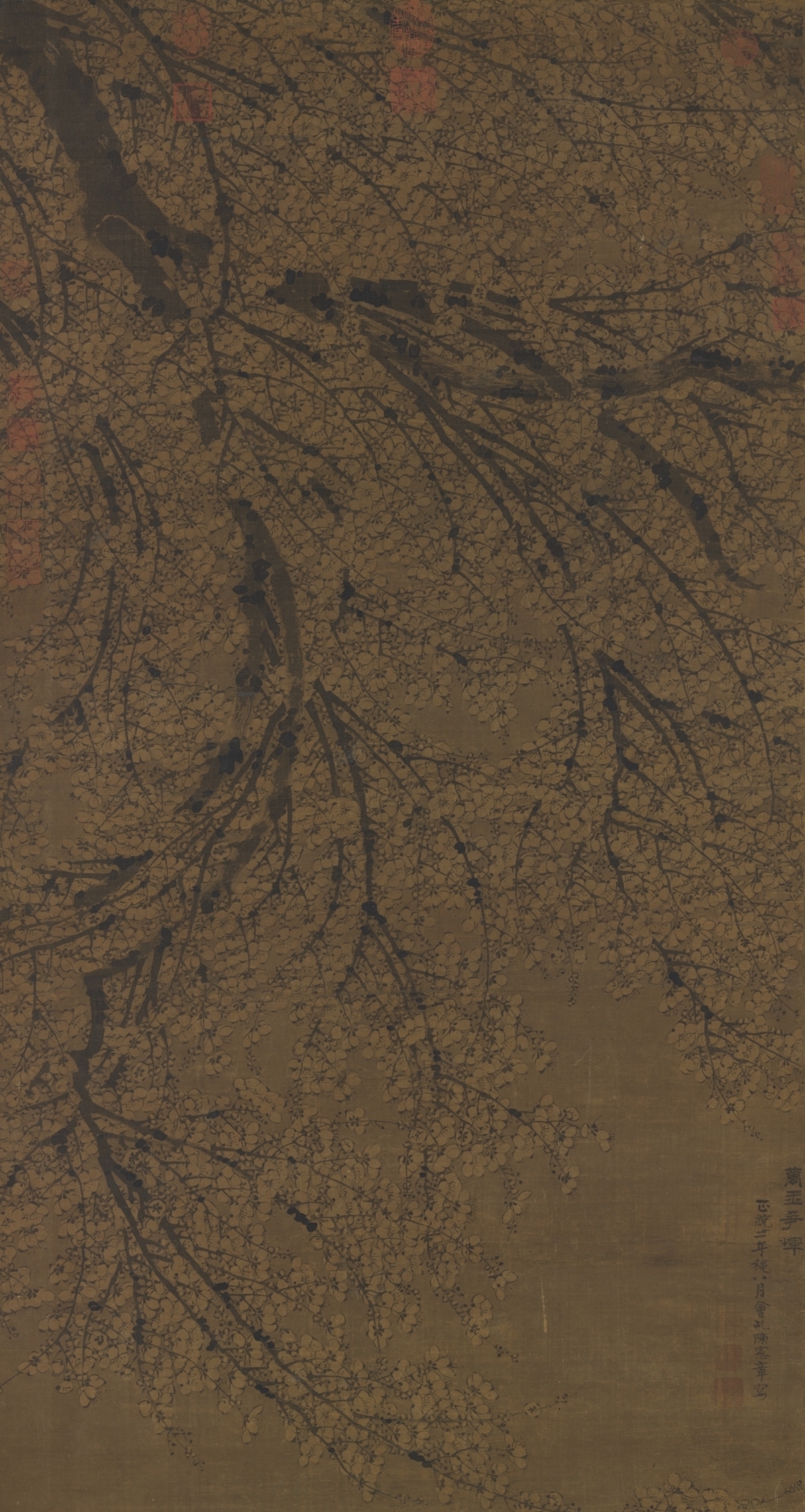
Ming Chen Xianzhang Painting Plum Blossom Axis Taipei Palace Museum Collection
Chen Xianzhang, who was active in Ming Yingzong Zhengtong (1436-1499), was born in Kuaiji, Zhejiang. He was good at painting plum blossoms, but the date of his birth and death is unknown. The records in the history of painting only say that he is as famous as Wang Qian at the same time. This work depicts plum blossoms hanging horizontally, and the main branches are divided into two branches. They are all drawn in a thicker ink color, and thicker ink moss is added. The plum blossoms are expressed in the form of circular petals, and the silk base is fully rendered with light ink, which sets off the whiteness of the petals. The whole painting is not about the clearness of the plum blossoms, but to construct the dense scenery and draw the denseness of the plum blossoms. Among the thousands of flowers and petals, it presents a lively scene of blooming flowers, which is quite a special way of composition.
Ming Dynasty Chen Xianzhang Wanyu Picture Axis
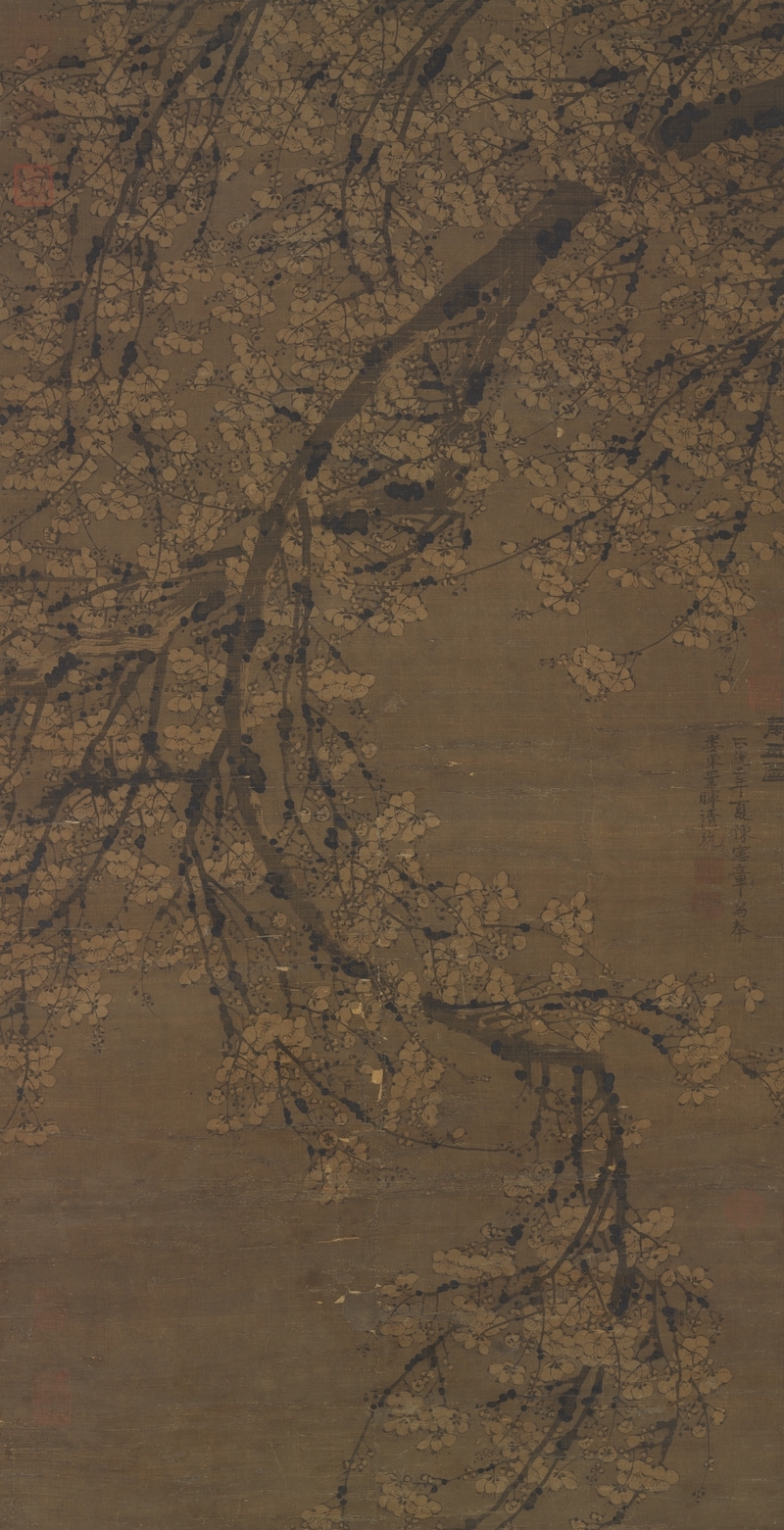
Ming Dynasty Chen Xianzhang Wanyu Picture Axis Collection of the National Palace Museum in Taipei
This painting is old and dry, with thousands of flowers like jade, complicated and lively. The branches and petals of the Chen family are very similar to those of Wang Mian. Only after careful observation, I found that Wang Yuanzhang's brush was slightly square, while Chen's was slightly round and thick. Wang is from Zhuji, lives in Kuaiji, and is in the same area as Chen Wei, and the origin of the two should be understood.
Minglu Plum Blossom Axis
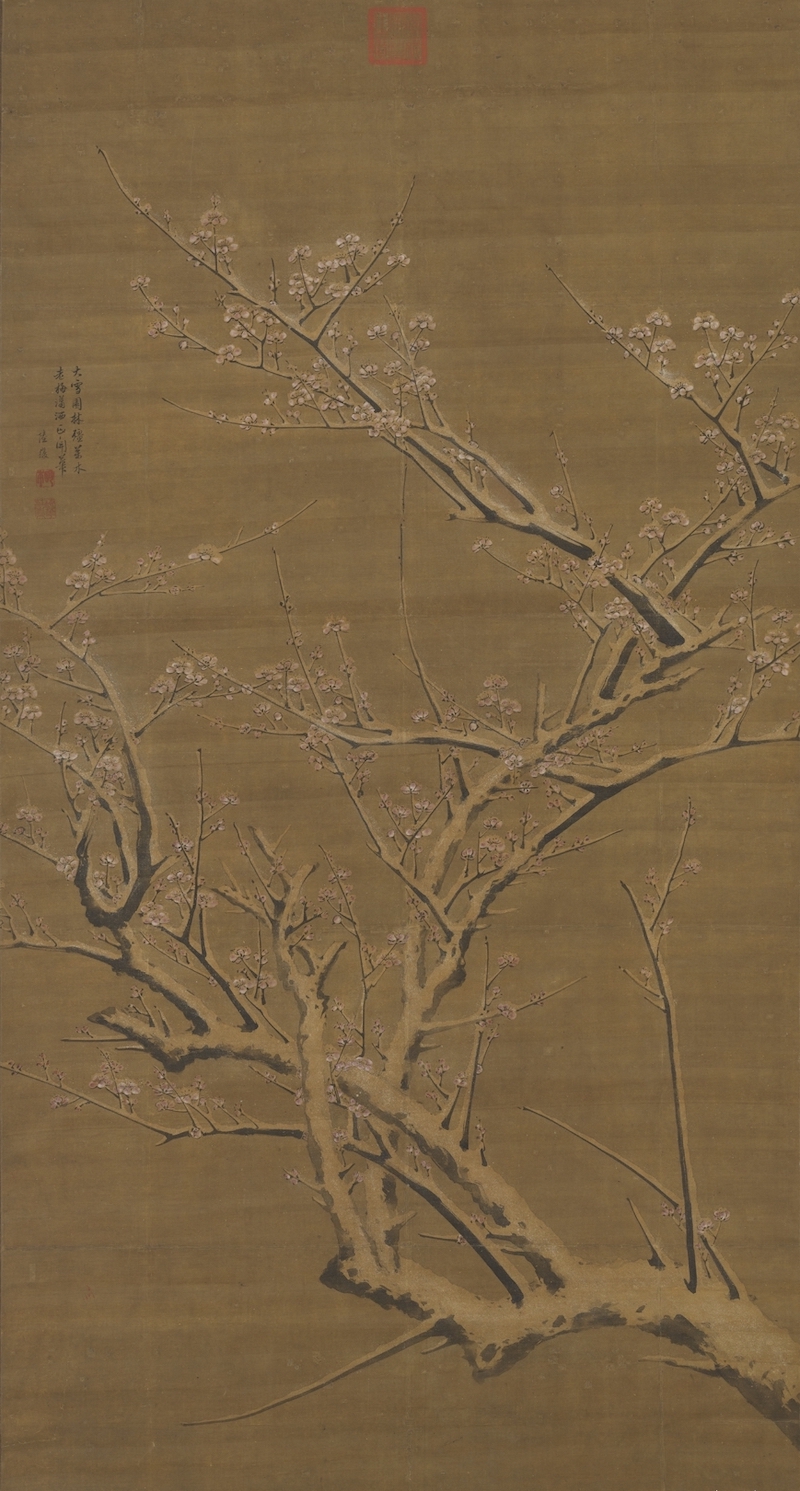
Ming Lu Fu Plum Blossom Axis Collection of the National Palace Museum, Taipei
Lu Fu, born in Wujiang (now Suzhou, Jiangsu), whose birth and death are not recorded in the history of New Year pictures. Zi Mingben, self-titled the owner of Meihuazhuang, is good at painting ink plums.
This painting of Xuemei Yishu, the painting method was derived from Wang Mian at the end of Yuan Dynasty, with slight changes. The branches are painted with the flying white method, and then dyed with light ink to set off. The petals are dotted with powder and slightly outlined.
Qing Dynasty Zhuda Ancient Plum Picture Axis
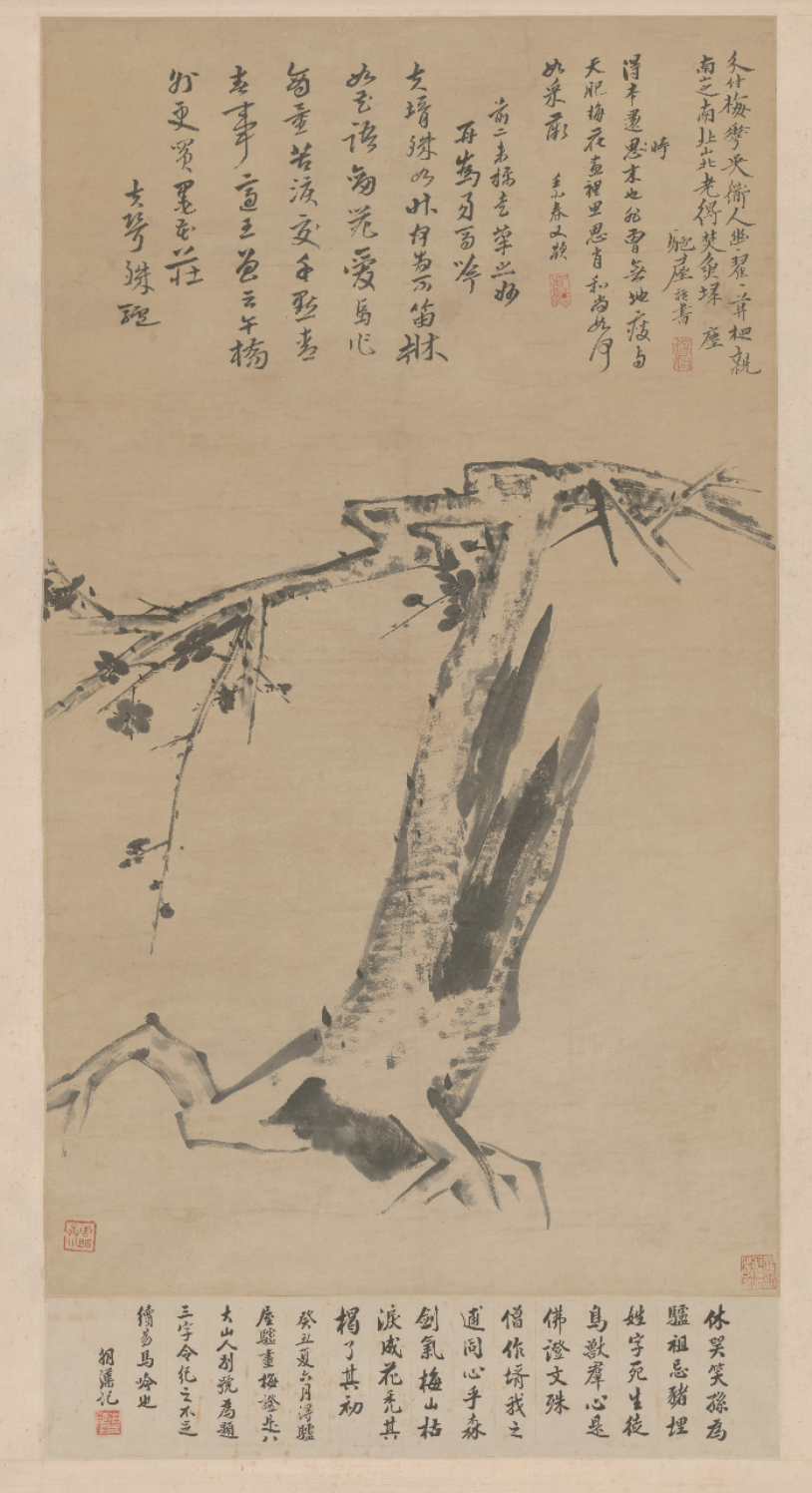
Qing Dynasty Zhuda Ancient Plum Picture Axis Collection of the Palace Museum
The picture depicts an ancient plum tree with no soil at the root, a hollow tree center, and several plum blossoms blooming on the side branches, showing tenacious vitality. According to the self-titled poem in the painting: "Sisi Xiao in the Plum Blossom Painting", this picture is Zhu Da's imitation of Zheng Sixiao, a painter of the Song dynasty, who painted orchids without land, implying that the land was taken by foreigners, expressing his love for the land. Nostalgia for the Ming Dynasty. The brush used in the picture is strong and powerful, the lines are rough, and there are many twists and turns. The combination of ink, dryness and moistening is full of expressive force. This picture is a representative work of Zhu Da in his middle age.
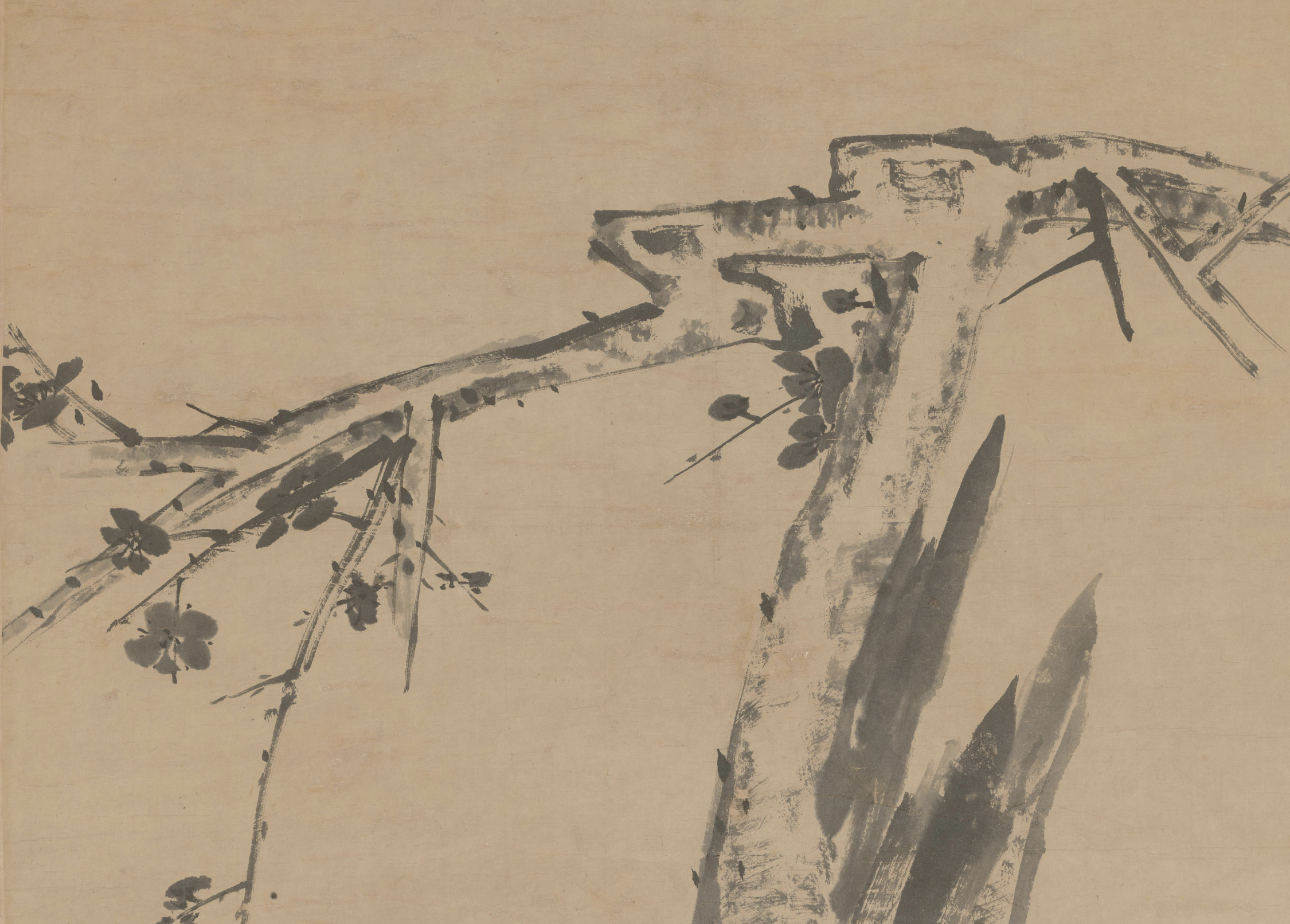
Axis of Zhuda Ancient Plum Picture in Qing Dynasty (partial) Collection of the Palace Museum
In this painting, Zhu Da himself inscribed three poems, which were inscribed separately: "Donkey House Donkey Book", sealed with "Zi Ri Nian" Zhu Wenyin; "Ren Xiaochun Another Inscription", sealed with "Donkey" Zhu Wenyin; "Ren Xiaochun" refers to the 21st year of Emperor Kangxi of the Qing Dynasty (1682), when Zhu Da was 57 years old.
There is an inscription by Luo Chaohan under the painting. There are "Huizu Zhai" Zhu Wenyin and "Daxing Liu Quanfu's Family Shouyin" Baiwen seal in the collection.
Qing Xiaoyun from plum blossom album
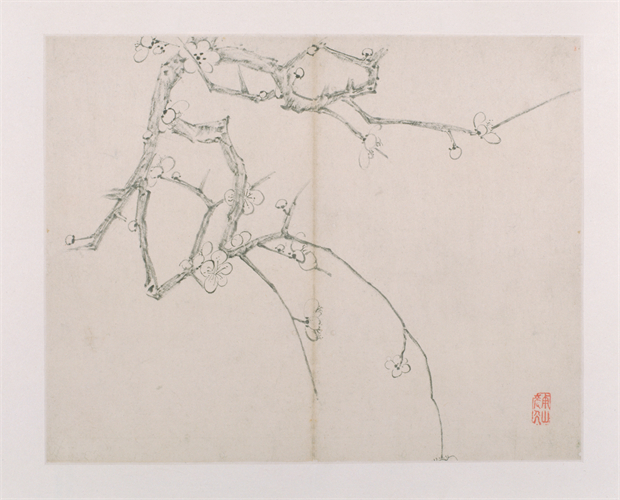
Qing Xiaoyun from Plum Blossom Atlas Collection of the Palace Museum

Qing Xiaoyun from Plum Blossom Atlas Collection of the Palace Museum
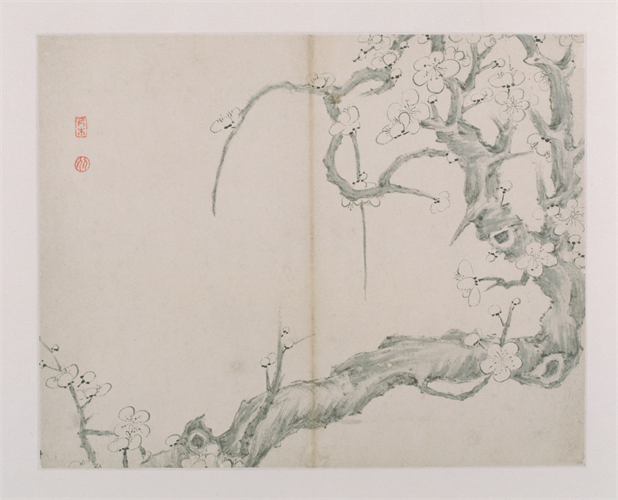
Qing Xiaoyun from Plum Blossom Atlas Collection of the Palace Museum
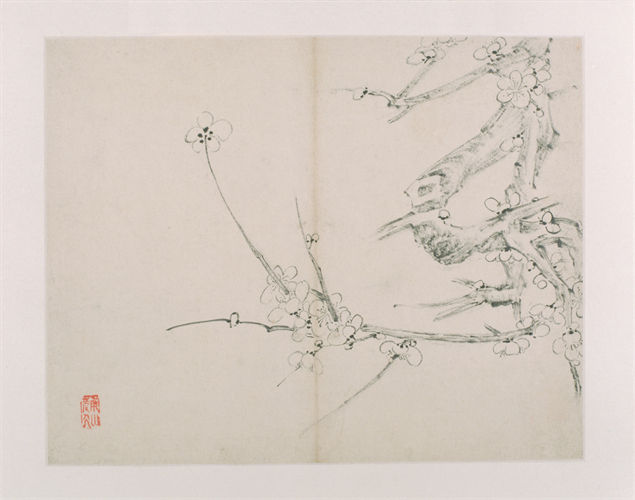
Qing Xiaoyun from Plum Blossom Atlas Collection of the Palace Museum
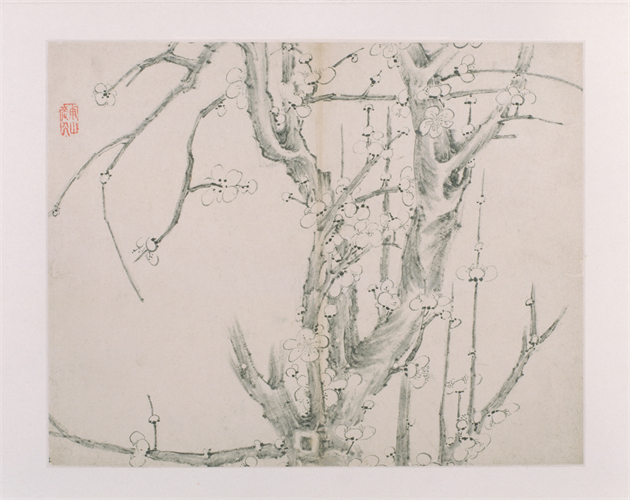
Qing Xiaoyun from Plum Blossom Atlas Collection of the Palace Museum

Qing Xiaoyun from Plum Blossom Atlas Collection of the Palace Museum
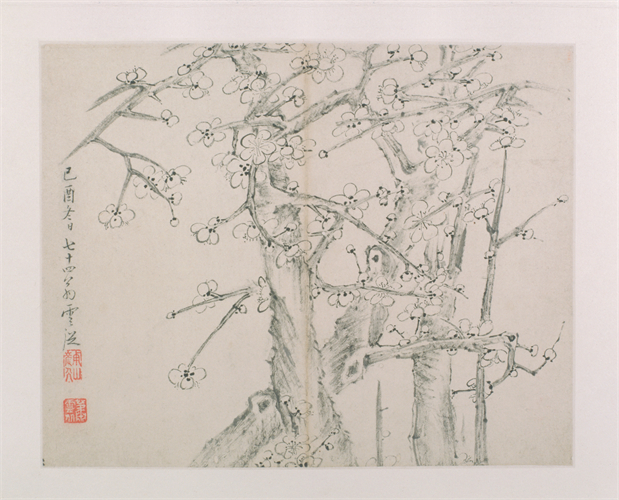
Qing Xiaoyun from Plum Blossom Atlas Collection of the Palace Museum
There are eight pages in this set of albums, seven of which have a square seal of "Zhongshan Old Man" Zhu Wenchang, "Chimu" Zhu Wenchang's seal, "Cong" Zhu Wen's round seal, "Xiao Yuncong" Bai Wen's long square seal, and the last one is from the Title "Jiyou Winter Day, Seventy-Four Wengs, Yun Cong", with "Zhongshan Old Man" Zhu Wenchang's square seal, "Xiao Yuncong" Bai Wenchang's square seal.
In ancient China, plum, orchid, bamboo, and chrysanthemum were collectively called the "Four Gentlemen", which were used to express the elegant temperament and noble quality of characters, so they were often used in paintings. This picture is one of them. The whole set of atlases depicts eight parts of Ling Han's plum blossoms blooming alone. Different from other painters who mostly depict plum blossoms and scattered scenes, Xiao Yuncong highlights the curvy branches, and the plum blossoms are only for decoration. Through the dense arrangement of the layout and simple brush and ink techniques, it shows a kind of coldness. Xiao Shu's artistic conception.
Axis of Nongmo Mei in Qing Dynasty
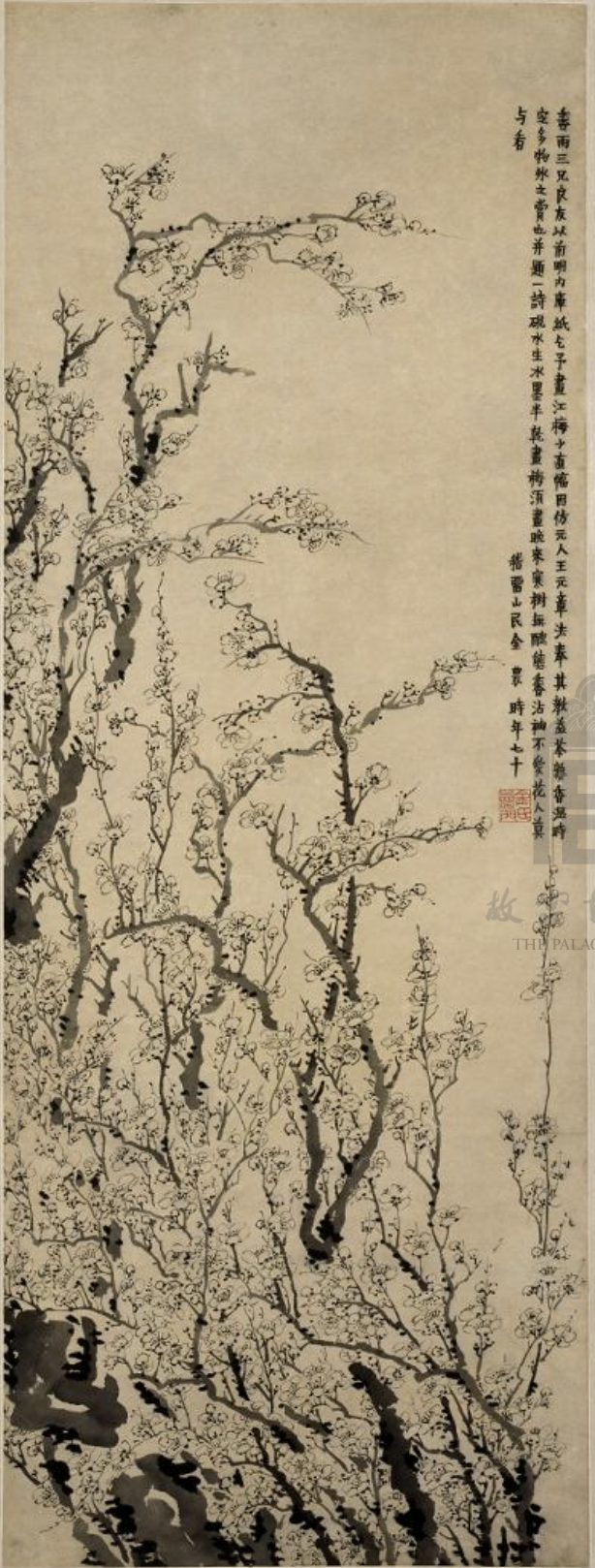
Axis of Nongmo Mei in Jin Dynasty, Qing Dynasty Collection of the Palace Museum
The title of this painting is: "Xiangyu's three brothers and good friends used to beg for a small straight painting of Jiangmei in the inner library of the Ming Dynasty. Because of the imitation of Wang Yuanzhang's method in the Yuan Dynasty. Based on his teachings, there are many rewards outside of things when the tea is ripe, fragrant and warm. He also wrote a poem: Inkstone water is raw and ice ink is half dry, and painting plums must be painted in the late cold. The tree has no ugly appearance and fragrance sticks to the sleeves, and people who don’t love flowers should not look at it. Jinnong, a Jiliu mountain man, was seventy years old. Clan Shoumen" Zhu Wenyin.
In this painting, the plum blossoms are separated from the shadows and full of vitality. Write the branches with moist light ink, and outline the stamens with a fine brush. The whole picture is leisurely and elegant.
Axis of Luopin Momei Picture in Qing Dynasty

Qing Luopin ink plum painting axis Palace Museum Collection
Title: "Bai Yuchan is good at painting plums. The plum branches are cut off several types of thorns. The flowers are very numerous. The cold flower and frozen calyx do not know anyone in the world. Yuchan's original surname is Ge and his name is Changgeng. When he travels around the sea, his name is Haiqiongzi, and he is also called Bin'an , Wuyi Sanren, Shenxiao Sanli, and Ziqing Zhenren are almost immortals. In the past, I saw that his small inscriptions on poems were also clear, and now there are quite a few of them. I was originally named Liangfengzi, and also named Huazhisi The monk, the man from Jinniushan, the fisherman from Liaozhou, the man from Luqiu, and the man from Renri have been in harmony with each other for thousands of years. This frame is traced back to the origin of Jue painting plum blossoms by Mr. Yunfeng. Jihai Meng Dongluo's employment record". The seal "Two Peaks" is printed in white. "Jihai" refers to the forty-fourth year of Qianlong (1779), when Luo Pin was 47 years old.
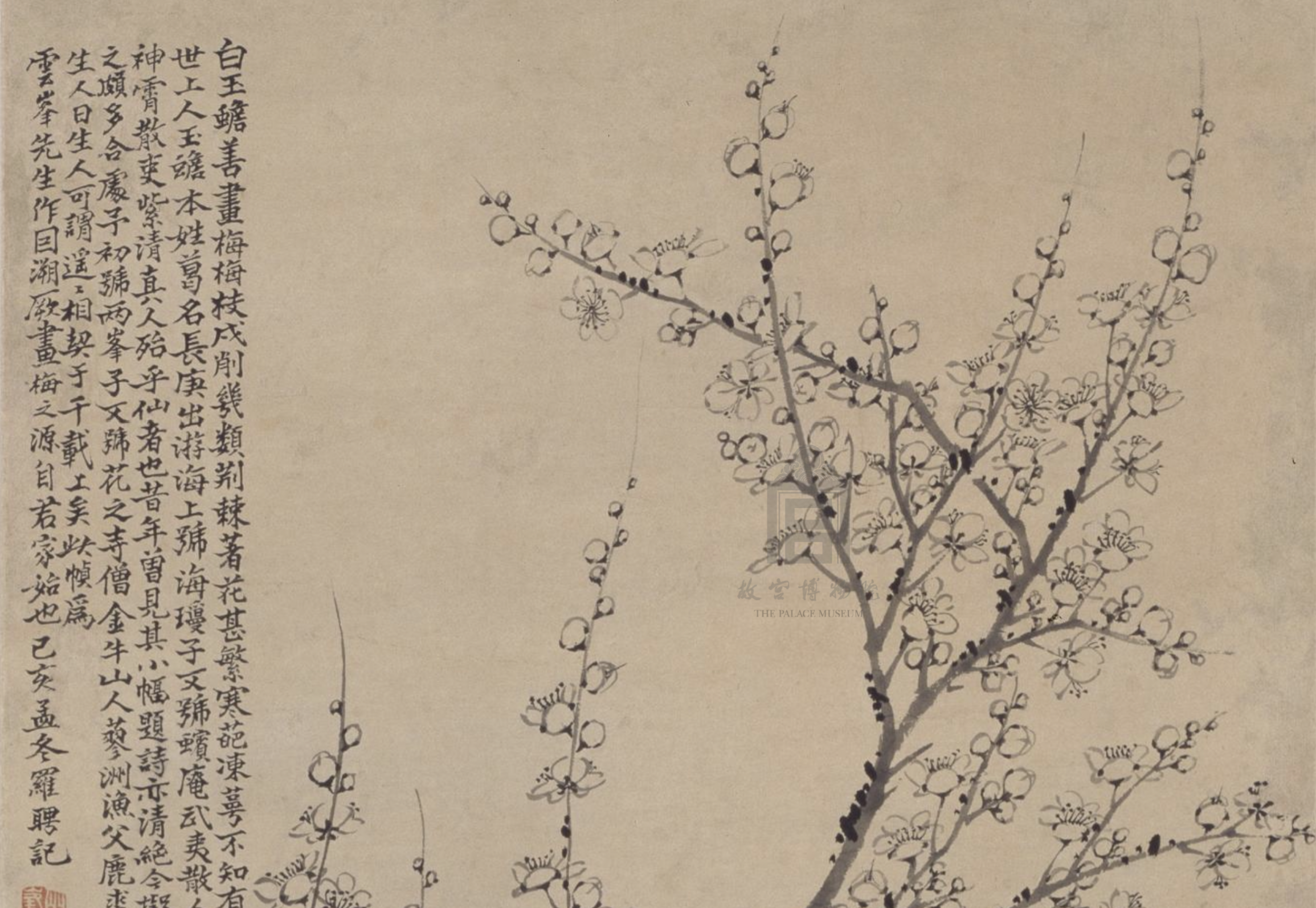
Axis of Luopin Momei Picture in Qing Dynasty (partial) Collection of the Palace Museum
The picture shows plum blossoms blooming proudly in the wind and cold, creating a vibrant scene. The petals in the picture are either imitated by Yuan Zhao Mengfu's "ink and wash" method, or imitated by Yuan Wang Mian's "empty circle" normal line. , leaving only the beauty of Qing Qi filling the universe", this kind of temperament is exactly the pure charm that the author wants to pursue after imitating Ge Changgeng's plum paintings in the Southern Song Dynasty.
Axis of Plum Blossoms in Wang Shishen, Qing Dynasty

Qingwang Shishen Plum Blossom Picture Axis Collection of the Palace Museum
The picture depicts a plum tree full of vitality, the blooming plum blossoms are pure and flawless, and the intertwined branches are swaying upwards, showing the lofty spirit of the plum as a gentleman among flowers who "does not love the beautiful places in the world, but goes to the cold mountain alone to be the proud son". In this picture, the plum blossoms are outlined in light ink, with fine lines, and the dried plums are drawn in a single stroke of thick ink, dripping with ink. The stems and flowers subtly form a contrast between black and white, making the simple picture without losing the level of change.

Axis of Plum Blossoms in Shishen, Qing Dynasty (partial) Collection of the Palace Museum
Department of money: "Yongzheng Yimaoqiu July 8th, my neighbor Wang Shishen wrote it under the shade of bananas in Chaolin Book Hall." Seal "Shishen private seal" Bai Wenyin, "near man" Zhu Wenyin, "Bingyinren" Bai Wenyin . In the lower right corner of the painting, there is an inscription by Pan Gongshou, inscription: "Two days after Daoguang Renyin Chong Ninth Day, the sea of people is hidden in Gongshou knowledge." Sealed "Gongshou" Zhu Wenyin.
"Yi Mao" is the thirteenth year of Yongzheng (1735). The author was 50 years old at the time, and his left eye, which has been suffering from a long-term disease, has not yet lost his sight.
Qing Gaoxiang Plum Blossom Figure Axis

Qing Gaoxiang Plum Blossom Picture Axis Collection of the Palace Museum
Inscription: "Chanzhi Temple explores the plum blossoms and records the rhyme between the walls of Dongpo to invite Mr. Murfu to smile. The guest of the first land arrives in autumn, and Gao Ke bids his farewell to the chilly cicadas. The east wind changes the climate, and the ancient plums are cold and smoked. Fen strips brush the eaves and tiles, and the color is □ □□Shown. Ridges (brush) hold the Buddha Pavilion, and a chime hangs in the spring mountain. Watching the Su and the bean, and cherishing the fairy forest. Forget about making friends, and eagerly looking forward to the sages. Meals are divided into monk bowls, cooking words and cutting flying springs. Forest trees gather haze , the early moon rises to the moon. Aided backs drive clouds and cranes, and sleeves flutter in the wind. The wild shop calls for fragrant wine, and He Xiuran is madly drunk. Gao Xiang, a student of the Western Tang Dynasty.
Re-title: "Horizontal iron stems protrude from the slanted eaves. It is a pity that spring enters the river city. There are plum blossoms and wind and rain, and the westerly wind is jealous of plum blossoms. Xiaoyan Yeyue is lonely and late, and when the bamboo fence is cherished, there are plum blossoms. The wind and the wind and the wind and the wind and rain make people feel melancholy and worry about the spring. The lonely root and thin shadow rest in the mountains and forests, and the fragrance can not be found in the dark. When there are plum blossoms, there will be wind and rain, and one branch will still keep the year old and chill. Mr. Liu Chuang used Yu Zha's Chinese language Ye Yun, which is four unique, please smile together, brother Murfu, old friend. Di Xiang nodded again." Seal "The Seal of the Western Tang Dynasty", "Phoenix Talisman".
This picture was made for Murph after Gao Xiang and his friends went to Yangzhou Chanzhi Temple to explore plum blossoms. The plum blossoms painted by Gao Xiang are all sparse and thin, with a unique charm, which is dewy and cool. Compared with the plum blossoms painted by Wang Shishen, they can be said to be different. The layout of this picture is unique. In the middle of the picture, a branch of red plum rises tall and straight. The inscriptions occupy two sides. The stretched plum branches divide the picture in a balanced and skillful manner. Dried plums are sparse in shape, with bony bones, and the faint plum blossoms are quiet and elegant. Jin Nong once vividly commented on Gao Xiangzhi's plum blossoms: "Half-opened flowers, use Yulou liposuction to smear a little red." This picture can be seen. In terms of painting techniques, Gao Xiang was influenced by Hongren, using concise brushwork and cherishing ink like gold. In addition, he also pays attention to the use of calligraphy in paintings. His running script with the meaning of official script has the characteristics of thin, hard and strong, which is unified with the simple, thin and beautiful style of plum blossoms and complements each other.
Qing Dynasty Li Fang Ying Momei Picture Axis

Qing Dynasty Li Fang Ying Mo Mei Tu Axis Collection of the Palace Museum
Title: "Ten days of kitchen smoke breaks the rice cooker, and the eyebrows of the ancient plum are soothed with a few strokes. The home-cooked meal of Binghuaxuerui is full of spring breeze and never hungry. Written in Jinling in October of the 19th year of Qianlong. Li Fangying. "Seal seal", "dream in a dream", "exchanging rice for life", "ying", "plum blossom means", "small window wind and rain" and so on. Appreciation and collection seal "Chu Zhen". The nineteenth year of Qianlong was 1754. After Li Fangying was dismissed from office, he made a living by selling paintings, and lived in poverty. The poems in the paintings reflect his optimistic spirit of enduring hunger and painting.
The ancients painted plums with thousands of flowers and ten thousand stamens, or withered branches and sparse flowers. Most of the plum trees have twisted branches and swaying. Li Fangying loves painting plums the most. He once wrote a poem about plums: "It may not be the right time to write plums. Don't blame the flowers before the ink falls. There are tens of thousands of flowers, but there are only two or three branches that are pleasing to the eye." Among the plum blossoms, the painter captures the most pleasing two or three branches, and through artistic conception, creates a more perfect artistic image than the natural plum blossoms. Less is better than more, which is endlessly memorable. Zheng Banqiao praised this.
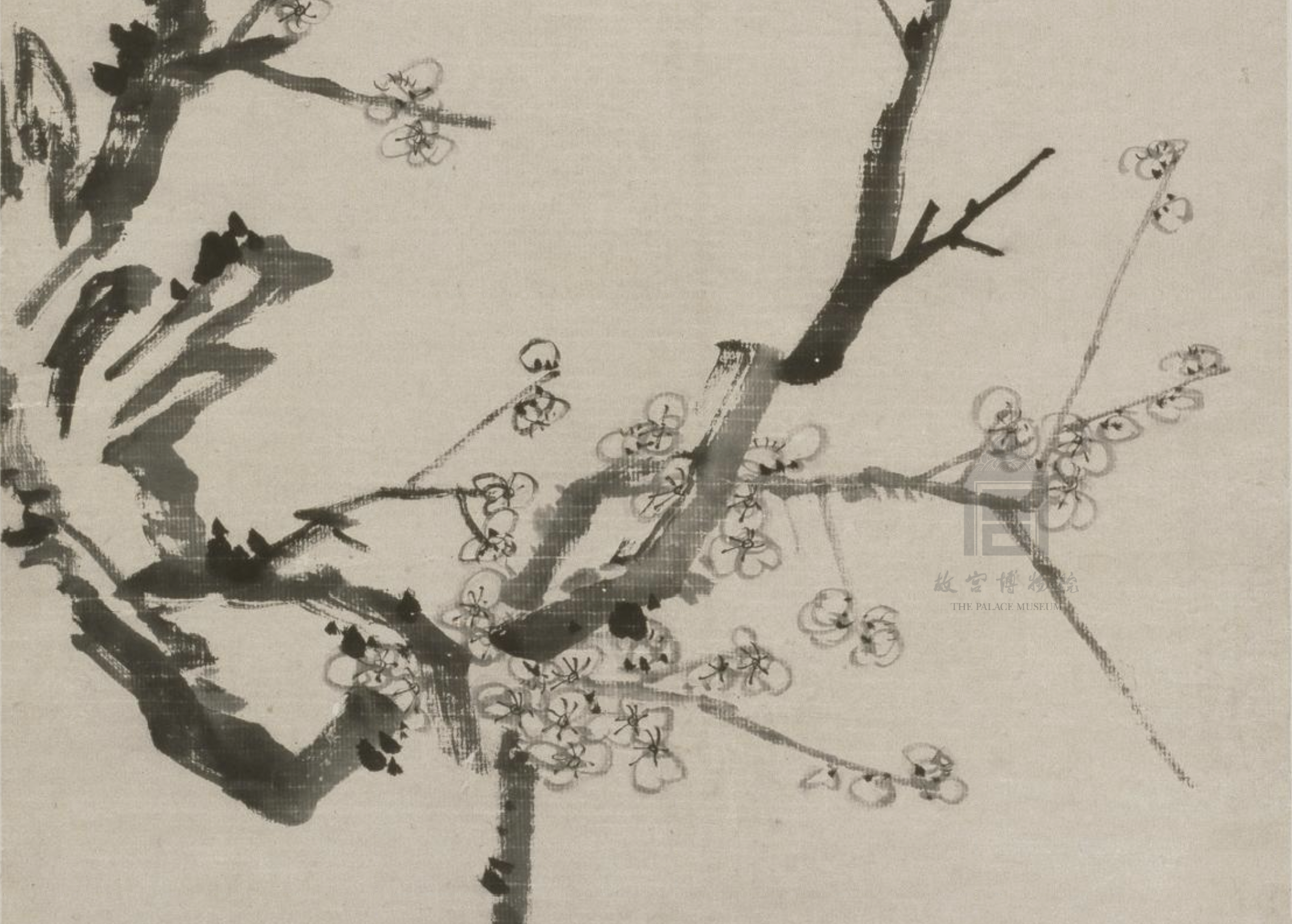
Qing Dynasty Li Fangying ink plum painting axis (partial) Collection of the Palace Museum
The broken-branched plum blossoms in the picture have strong individual characteristics. The plum blossoms are "rampantly heroic", and the plum blossoms are round and unrestrained, with a dark fragrance and sparse shadows, giving them a lonely and solemn demeanor. Li Fangying's good friend Yuan Mei commented on his plums, saying: "The roots of plum trees are made of pride, and the flowers of plum trees are scattered by geniuses", which clearly explains the reason why he formed this style. Li Fangying's love of plums has become an addiction, so he has the seal of "a lifelong confidant". Yuan Mei's words can be described as straightforward, stubborn, and full of righteousness. The words of a confidant.
(This article is compiled based on relevant materials from the Palace Museum and Taipei Palace Museum.)
